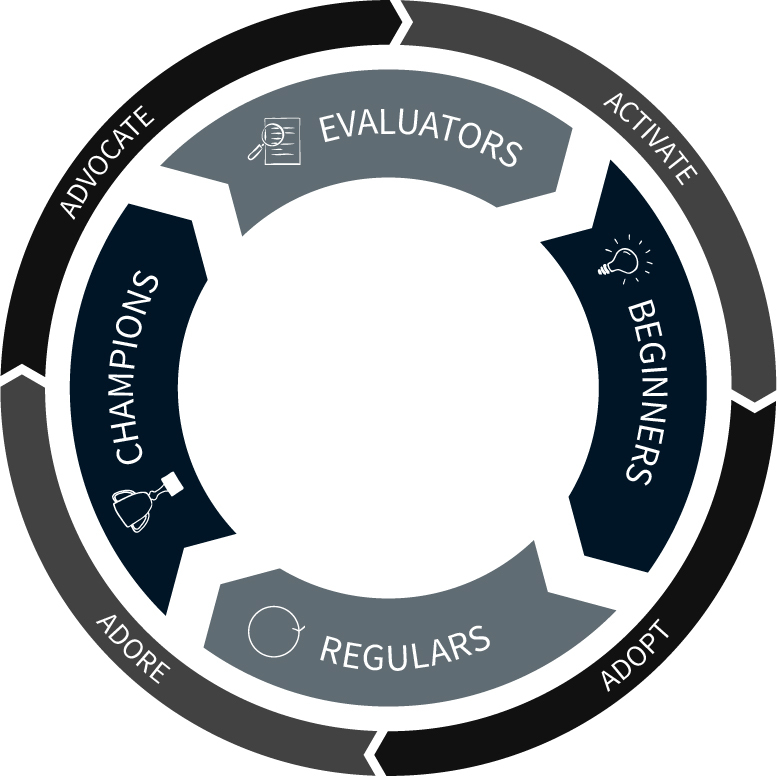
How to measure customer satisfaction when seeking product-led growth
18 Aug 2021 • Strategy & Business Design
The development of a digital product certainly doesn’t end when it has been successfully launched to the market. Even if you spent hundreds of hours on market research and mapping user needs, do you still dare to swear blind that your customers are satisfied and get enough value from your product? We gathered nine tips to measure customer satisfaction in a way that serves product development and thus ensures your customers remain committed to your product and accelerate product-led growth.
1. Your regulars and champions are your best source of information
The Flywheel model familiar from the theories of product-led growth helps to perceive the users’ journey from experimenting and adopting the product to becoming a regular and a champion. Especially the two latter user groups, Regulars and Champions, are probably very willing to share their thoughts. While it’s important to measure customer satisfaction throughout the lifecycle, your Regulars and Champions are most committed to your product and therefore most motivated to giving feedback and influencing the improvements made to a product that’s important to them.

2. Good old surveys seldom fail
Traditional surveys equipped with multiple choice questions or smiley faces are an inexpensive, efficient and effortless way of measuring customer satisfaction from larger masses. In particular, surveys embedded in e-mails tend to generate successful response rates but the same forms can be easily applied to other channels as well, from websites to mobile applications.
What matters the most is that you collect feedback from where it’s the most convenient to the customer. If a customer needs to put even the slightest bit of effort into giving feedback, they will most likely skip the opportunity. Do you bother to look for feedback boxes on company websites unless you are exceptionally pleased or disappointed? Also, small rewards such as giveaways and discount codes could lower the bar for giving feedback.
3. Collect feedback in that channel and phase of the customer journey you want to measure the satisfaction of
When you collect feedback in the specific channel and phase of the user journey you are planning on improving, you reach your customers at their most committed, and they don’t have to dig into their memory past the last couple of minutes. For instance, if you want to map customer satisfaction to product introduction, schedule a survey right after customers have completed all the measures required for introduction. Or, if your goal is to measure satisfaction with your mobile application, ask for feedback directly through the app.
4. Utilize the data of customer satisfaction metrics
Most companies are probably collecting feedback with different metrics and scorings, such as Net Promoter Score, Customer Satisfaction Index, or churn rates. These types of metrics have their time and place, as they are simple, comparable, and give a good overview of customer happiness with a quick glance. However, you could divide your customer base further into smaller segments with the help of these metrics. Perhaps you notice a pattern repeating with specifically happy or unsatisfied customers? Or could customers who gave lower scores have a shared need your product might not be able to solve? You could also approach these questions by tailoring separate surveys for each segment.
5. Ask for qualitative feedback as well
With qualitative feedback, you’ll be able to extend your understanding beyond numbers. You could, for instance, dig into interesting details surfaced from the quantitative surveys. You can collect qualitative feedback via e-mail or in-app surveys with open-end questions, to mention a few examples. Also, don’t forget the so-called old school techniques: simply grab the phone or ask for feedback face-to-face, and you’ll get straight to the point. Asking for feedback in person or via video, you’ll also be able to ask clarifying questions and sense the real moods and messages between the lines.
6. Conduct win-loss interviews
Can you name which features of your product are better than your competitors’ according to your customers, and which features might need further improvements? By conducting win-loss interviews, you might find out entirely new perspectives and details you might not have realized to ask directly.
7. Sales team should keep their eyes and ears open
Measuring customer satisfaction and collecting feedback shouldn’t be left on the shoulders of the customer service team alone. Salespeople are most in touch with potential customers and can thus observe what kind of first impressions, questions and comments about the product arise. Salespeople are also likely to have the most comprehensive view of the reasons why a product is not purchased. On the other hand, if sales of your digital product run without actual human contact, you can, for example, target a simple questionnaire to visitors who appear to be leaving your website.
8. Remember to maintain a reasonable scale
Naturally, it’s impossible to react to every single feedback of your product, and you can’t serve every individual preference your customers have. You simply can’t please everyone. Instead of focusing on singular customer wishes, try to look for bigger trends.
9. Keep your customers in the loop
Product development based on customer feedback doesn’t have to be done in secret. Instead, you should communicate about new features and improvements openly and with pride. This way, you could reach previously hesitant potential customers and win back the trust of your currently dissatisfied customer. When it comes to product-led growth, it’s essential to strive to hold on to your existing customers that hopefully will commit to your product and with time become its advocates. In Tomi Neulanen’s blog, you can study more tips to get your customers to return to your digital product over and over again.
Did you find this blog insightful? Check out our other blog posts regarding product-led growth.
Shortcuts
- 1. Your regulars and champions are your best source of information
- 2. Good old surveys seldom fail
- 3. Collect feedback in that channel and phase of the customer journey you want to measure the satisfaction of
- 4. Utilize the data of customer satisfaction metrics
- 5. Ask for qualitative feedback as well
- 6. Conduct win-loss interviews
- 7. Sales team should keep their eyes and ears open
- 8. Remember to maintain a reasonable scale
- 9. Keep your customers in the loop
- Did you find this blog insightful? Check out our other blog posts regarding product-led growth.






